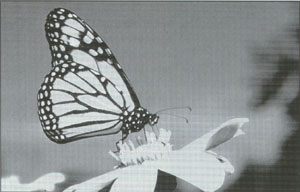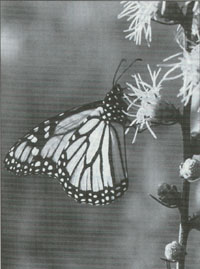 |
Home | Search | Browse | About IPO | Staff | Links |
 |
Home | Search | Browse | About IPO | Staff | Links |
|
Photograph courtesy of Michael Jeffords  THE LONG-DISTANCE FLUTTER Each fall, Illinois' monarch butterflies join an amazing migration that stretches some two thousand miles from Canada to Mexico. We're still Learning how and why CHASING MONARCHS:MIGRATING WITH THE BUTTERFLIES OF PASSAGE Robert Michael Pyle, 1999 Houghton Mifflin It's easy to start seeing things after reading Robert Michael Pyle. A spot of color at the side of the road can suddenly morph from leaf fall to willful flight. Or the other way around. Pyle experiences the same problem. But for him it's an occupational hazard. He watches butterflies for a living. That's tougher than it sounds, it seems. Pyle, the author of The Audubon Society Field Guide to North American Butterflies, spent 57 days in 1996 trekking 9,462 miles in an effort to track and tag monarchs on their south-moving fall migration, the most amazing of all lepidopteran journeys. He chased now-you-see-it, now-you-don't blurs of orange and black down back roads, across Pacific Northwest rivers, over Western mountains and through Southwestern deserts to prove there isn't a hard-and-fast continental divide between the migratory routes of this bicoastal tribe. It's generally believed that all West-ern monarchs overwinter on the tall eucalypts along the California coast, while all Eastern monarchs, including those that pollinate the gardens and prairies of the Great Lakes region, overwinter on ancient firs in the Mexican highlands. This is a relatively recent observation because the roosts in the Oyamel, also called the "sacred firs," weren't discov-ered by the scientific community until 1975. And Pyle is not attempting to destroy altogether this map of the monarchs' parallel drive southward in the fall and northward in the spring. But in his latest book, Chasing Monarchs: Migrating with the Butterflies of Passage, published last year, Pyle does set out to shake prevailing wisdom. He decides he can accomplish this by following each monarch he sees wherever it goes, from western Canada south. This is hardly a fool's errand. Pyle, a noted entomologist and naturalist, had some prior evidence. He cites instances of tagged monarchs that have crossed the divide. And he satisfies himself that some Western monarchs fly south into Mexico. Pyle's account, he might be the first to admit, manages to add detail to the known biological story, while simultaneously enhancing its mystery. And what a mystery. It's been a long wait this year, though. Through much of the summer, the Springfield area was strangely bereft of most butterflies, including the monarch. It seemed they had ceded the turf in this central Illinois neighbor-hood to the everywhere-you-look cabbage whites. Then, on the last day of July, there they were. The bold-as-can-be blue-black pipevine swallowtail, nectaring 34 | September 2000 Illinois Issues www.uis.edu/~ilissues --- Photograph courtesy of Michael Jeffords  on Verbena bonariensis, a tall annual that doubles as a lavender butterfly beacon, an aloof tiger swallowtail, the diminutive eastern tailed blue. And the monarch, big enough and bright enough to be seen from yards away, nectaring on a Buddleia davidii, the aptly named butterfly bush. It allowed closer inpection, just enough to see it wasnít the mimic viceroy, a smaller version of the monarch distinquished by black lines across its hind wings, yet too skittish to allow itself to be identified by gender ó the males have black patches at the center of their hindwings. Male or female, this specimen was but a harbin-ger of the mass migration to come. And there was surely time to propogate one last generation. That generation, unlike the others, will not breed for months, not until the trip back from its winter roost. If this was a female, she surely saw the orange milkweed, the host plant for her offspring, though hiding nearby were the still-tiny descendents of last summerís garden resident, the swift and magnificent mantis. Insect carnivores are not the monarchís only worry. Birds, too, can and will take a monarch, though the juice of the milkweed provides a mild toxic protec-tion. Most birds soon learn orange and black is distasteful. So the look-alike viceroys get a free ride of sorts.
But people are the monarchsí most
serious threat. Dangerous because they
are so indifferent. Pyle is struck by how
few people really see butterflies, even in
mass aggregation. Though he doesnít
actually say it, if butterflies remain
invisible on the human-defined land-
scape, they could disappear altogether.
Fortunately, itís easy to start seeing
things after reading this book.
www.uis.edu/~ilissues Illinois Issues September 2000 | 35 ---
|